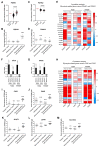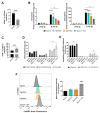Refining the Role of Pyruvate Dehydrogenase Kinases in Glioblastoma Development
- PMID: 35954433
- PMCID: PMC9367285
- DOI: 10.3390/cancers14153769
Refining the Role of Pyruvate Dehydrogenase Kinases in Glioblastoma Development
Abstract
Glioblastoma (GB) are the most frequent brain cancers. Aggressive growth and limited treatment options induce a median survival of 12-15 months. In addition to highly proliferative and invasive properties, GB cells show cancer-associated metabolic characteristics such as increased aerobic glycolysis. Pyruvate dehydrogenase (PDH) is a key enzyme complex at the crossroads between lactic fermentation and oxidative pathways, finely regulated by PDH kinases (PDHKs). PDHKs are often overexpressed in cancer cells to facilitate high glycolytic flux. We hypothesized that targeting PDHKs, by disturbing cancer metabolic homeostasis, would alter GB progression and render cells vulnerable to additional cancer treatment. Using patient databases, distinct expression patterns of PDHK1 and PDHK2 in GB tissues were obvious. To disturb protumoral glycolysis, we modulated PDH activity through the genetic or pharmacological inhibition of PDHK in patient-derived stem-like spheroids. Striking effects of PDHKs inhibition using dichloroacetate were observed in vitro on cell morphology and metabolism, resulting in increased intracellular ROS levels and decreased proliferation and invasion. In vivo findings confirmed a reduction in tumor size and better survival of mice implanted with PDHK1 and PDHK2 knockout cells. Adding a radiotherapeutic protocol further resulted in a reduction in tumor size and improved mouse survival in our model.
Keywords: DCA; glioblastoma; invasion; lactate; pyruvate dehydrogenase kinases.
Conflict of interest statement
The authors declare no conflict of interest.
Figures





Similar articles
-
Dichloroacetate, the Pyruvate Dehydrogenase Complex and the Modulation of mESC Pluripotency.PLoS One. 2015 Jul 6;10(7):e0131663. doi: 10.1371/journal.pone.0131663. eCollection 2015. PLoS One. 2015. PMID: 26147621 Free PMC article.
-
Blocking Aerobic Glycolysis by Targeting Pyruvate Dehydrogenase Kinase in Combination with EGFR TKI and Ionizing Radiation Increases Therapeutic Effect in Non-Small Cell Lung Cancer Cells.Cancers (Basel). 2021 Feb 24;13(5):941. doi: 10.3390/cancers13050941. Cancers (Basel). 2021. PMID: 33668151 Free PMC article.
-
Anemone rivularis inhibits pyruvate dehydrogenase kinase activity and tumor growth.J Ethnopharmacol. 2017 May 5;203:47-54. doi: 10.1016/j.jep.2017.03.034. Epub 2017 Mar 21. J Ethnopharmacol. 2017. PMID: 28341246
-
Microenvironmental control of glucose metabolism in tumors by regulation of pyruvate dehydrogenase.Int J Cancer. 2019 Feb 15;144(4):674-686. doi: 10.1002/ijc.31812. Epub 2018 Oct 4. Int J Cancer. 2019. PMID: 30121950 Free PMC article. Review.
-
AZD7545, a novel inhibitor of pyruvate dehydrogenase kinase 2 (PDHK2), activates pyruvate dehydrogenase in vivo and improves blood glucose control in obese (fa/fa) Zucker rats.Biochem Soc Trans. 2003 Dec;31(Pt 6):1165-7. doi: 10.1042/bst0311165. Biochem Soc Trans. 2003. PMID: 14641018 Review.
Cited by
-
Copper homeostasis and copper-induced cell death in tumor immunity: implications for therapeutic strategies in cancer immunotherapy.Biomark Res. 2024 Oct 31;12(1):130. doi: 10.1186/s40364-024-00677-8. Biomark Res. 2024. PMID: 39482784 Free PMC article. Review.
-
Metabolic reprogramming and signalling cross-talks in tumour-immune interaction: a system-level exploration.R Soc Open Sci. 2024 Mar 13;11(3):231574. doi: 10.1098/rsos.231574. eCollection 2024 Mar. R Soc Open Sci. 2024. PMID: 38481985 Free PMC article.
-
In Vivo and In Vitro Experimental Study Comparing the Effect of a Combination of Sodium Dichloroacetate and Valproic Acid with That of Temozolomide on Adult Glioblastoma.Int J Mol Sci. 2025 Jul 15;26(14):6784. doi: 10.3390/ijms26146784. Int J Mol Sci. 2025. PMID: 40725030 Free PMC article.
-
Impact of Salinity Stress on Antioxidant Enzyme Activity, Histopathology, and Gene Expression in the Hepatopancreas of the Oriental River Prawn, Macrobrachium nipponense.Animals (Basel). 2025 Aug 7;15(15):2319. doi: 10.3390/ani15152319. Animals (Basel). 2025. PMID: 40805105 Free PMC article.
-
Isoacteoside alleviates hepatocellular carcinoma progression by inhibiting PDHB-mediated reprogramming of glucose metabolism.Commun Biol. 2025 Feb 8;8(1):205. doi: 10.1038/s42003-025-07622-x. Commun Biol. 2025. PMID: 39922943 Free PMC article.
References
-
- Hanahan D. Hallmarks of Cancer: New Dimensions. Cancer Discov. 2022;12:31–46. doi: 10.1158/2159-8290.CD-21-1059. - DOI - PubMed
Grants and funding
LinkOut - more resources
Full Text Sources

